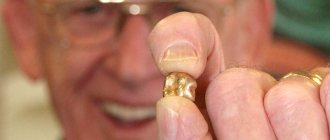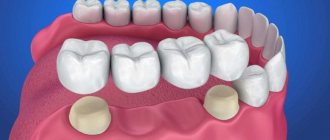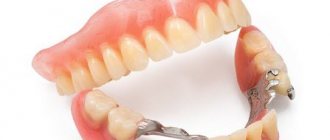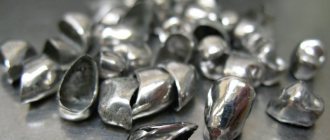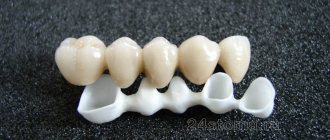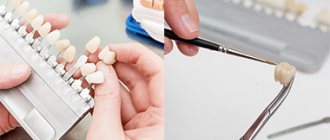A pebble in kozinaki, a fragment of a bone in a cutlet or sausage, an attempt to crack a nut shell with your teeth - these are the most common reasons why a tooth can be broken. Some will immediately call the dentist to fix the damage as soon as possible, while others will turn to the Internet for help, where they will certainly find articles about how the author restored his own tooth, put a filling at home, or even regrew a chipped piece. What is true, what is fiction, and what advice is downright dangerous to follow, we will talk today.
Soothe the pain
In order to clean the cavity of the hole from bacteria and thereby soothe the pain, purchase the drug “Santedents”. It is easy to use, and the results in the initial stages of caries can be pleasing. Finding this drug in a regular pharmacy is quite problematic. But you can buy everything on the Internet.
- Santedents powder is sold complete with a special solvent. Following the instructions, mix both components until you obtain a mixture that resembles clay in consistency.
- Brush your teeth thoroughly with regular toothpaste. Pay special attention to the location of the future filling. It will be better if you clean them several times.
- After this, brush your teeth with a mixture of baking soda and toothpaste.
- Place a small amount of mixture into the hole to close its cavity. Gently compact it with your fingers or a special spatula.
- In order for the product to stick and not be influenced by harmful microorganisms, cover the “sealed” tooth with thick petroleum jelly or vegetable oil.
- Now the hardest part awaits you. You will need to walk with your mouth open for 30 minutes. This is not very easy to do, but the result is worth it. During this time, the mixture is compacted into the tooth.
- After 6-8 hours, the “seal” can be removed. You cannot eat during this time. Therefore, we recommend performing this procedure at night.
- If after using Santedents the pain subsides, you have done everything right. It happens that after a while she returns. Then put the “seal” again.
Now you can give yourself a permanent filling. We will discuss below how to fill a tooth at home.
Installation of a permanent filling
If you decide to put a filling yourself, then you can use the Acrodent tooth filling material. The set includes 3 tubes and 2 bottles of cleaner. It should be remembered that if a tooth hurts, you cannot work on it without first cleaning it. In addition to Acrodent, you will need:
- hair dryer;
- dental spatulas (they are often included with the material, but can be purchased separately);
- cotton swabs.
Making a filling
- We brush our teeth in the same way as in the first case.
- Mix the components of the kit as written in the instructions. You should get an elastic mixture that resembles dough. You need to work with it quickly enough: after 5 minutes it will polymerize and harden like stone.
- Using a spatula, seal the bottom of the hole. To make the mixture more dense, tamp it with your finger.
- Use a hairdryer to dry the filling. We wipe away any drool with cotton swabs.
- We repeat the procedure with applying the material. Now you need to walk around with your mouth open for 10 minutes. During this time, the unpleasant odor of the acid contained in the solvent will completely disappear.
- After just 10 minutes, the filling will harden, but the hardening process will continue for up to 6 hours. During this period you will have to refrain from eating food.
- The filling is ready. If this tooth starts to hurt in a couple of weeks or months, a visit to the dentist is inevitable. Otherwise, you can pay at least a tooth.
How is the impression taken?
When the spoon has already been selected, the doctor performs the following manipulations:
- Using a spatula, the selected material is mixed.
- The mass is placed in a spoon, inserted into the mouth, and the spoon is pressed against the alveolar process. When taking an imprint from the lower jaw, press first from the front, then vice versa. If they work with the upper jaw, then they act in the reverse order.
- To harden the mass, leave it in the mouth for no more than five minutes. During this time, the impression hardens and preserves as accurately as possible all the features of the patient’s jaw.
- The edges of the impression are formed by the movements of the patient's tongue and lips.
- To avoid deformation of the impression, it is removed in one sharp movement.
- After washing, the impression is immersed in a special solution.
Precautionary measures
Unfortunately, the manufacturers of these products cannot guarantee a successful result. After all, the lion's share of success lies in correct dental diagnosis. By filling an insufficiently cleaned tooth, you create a place in its middle for various infections that multiply very quickly. An inflamed nerve cannot be saved in this way either. Therefore, it is best to monitor your dental health and have regular dental examinations. Then there will be no neglected problems and exorbitant expenses.
Methods of dental restoration: how to make dentures at home
Prosthetics is a popular dental service that helps restore the beauty and charm of a smile. Insufficient care, non-compliance with doctor's recommendations and mechanical damage lead to the formation of cracks and chips. Of course, you need to immediately contact a dental technician, but false teeth can be damaged during vacation or a business trip. It is not surprising that many people wonder how to make dentures at home.
Repair of a dental product is carried out using dichloroethane glue, which is applied to the split lines to glue the parts together. This stage is not final, but preparatory, intended for performing precise subsequent manipulations - preparing the plaster casting and connecting the parts.
Professionals use acrylic plastic and special resins to glue the prosthesis, which can only be purchased at a dental store. Some craftsmen seal it with wax extracted from a slightly melted prosthesis. This approach is recognized by dentists as incorrect and unreliable - most likely, the repaired product will not last even a week.
When restoring false jaws at home, it is better to rely on the work of masters. What is the process of restoring a prosthesis?
1. Sanding. There should be no unevenness or roughness on the surface of all parts of the product. This is done using carborundum stones or discs.
2. Cleaning. Each element of the prosthesis is removed from contamination and disinfected.
3. Assembly. All parts of the product are arranged in the correct order close to each other -
so that there are no gaps.
4. Gluing. This stage requires maximum care and concentration - an unsuccessful attempt to connect parts will lead to the fact that the product will finally become unusable.
If the prosthesis is repaired incorrectly, it is usually necessary to replace it with a new one. This is due to the fact that fresh lines by which the master could identify the break disappear and restoration becomes impossible. Buying a new prosthesis is much more expensive than repairing it. Therefore, before preparing to repair it yourself, it is better to think several times: is it worth the risk? Still, high-quality restoration of such a product can only be done by professionals.
In what cases can a fallen crown be put back?
Re-fixation of a permanent crown is possible if the following conditions are simultaneously present:
- if the supporting tooth is intact, has no chips or cracks,
- there is no need to treat/grind the tooth,
- if the prosthesis is not damaged or only slightly damaged: a small chip of ceramic on the metal “cap” can be restored.
It is also possible to reinstall a fallen temporary plastic or composite prosthesis. But all of the above conditions must also be met.
“A month and a half ago, I began to notice that the dental crown was moving out or seemed to be tilting. There was still no time to get to the doctor, and somehow I didn’t attach much importance. And while celebrating my sister’s birthday, I felt like I was chewing something wrong in my mouth. It turned out that the crown fell off while eating! I put it on a napkin and in my pocket. And the next day I went to the dentist. He examined everything, took an x-ray and said that we can glue it back and walk like this for a year or two.”
Alexander, review from the site irecommend.ru
Is it possible to fill a tooth yourself: how to make a filling with your own hands at home?
A limited budget often prevents filling a hole in a tooth in a dental clinic on time. The longer the hole remains open, the higher the risk of complications. The cavity and area of carious lesions increase in size, and dental tissues are completely destroyed over time.
If you don’t have enough money to go to the dentist and there are no concomitant oral diseases, you can solve the problem at home. Ready-made products from the pharmacy help you fill a tooth with your own hands at minimal cost.
Types of materials
Doctors use only modern and high-tech materials. Among the large selection offered by the market, the doctor focuses on the clinical situation and the specific purposes for which the impression will be used in the future.
Main criteria for material selection:
- Impression accuracy. In particular, it is necessary to accurately convey the contours of soft tissues that will be in direct contact with the prosthesis.
- Resistance to deformation after making an impression.
- The material should not be subject to shrinkage after contact with the external environment (air, light), and when exposed to an aggressive environment in the oral cavity.
Silicone-based materials are popular. They are quite plastic, so they allow you to achieve an accurate impression of all areas of the teeth, including the gingival areas. Most often they are used to create clasp models and ceramic crowns. However, it is necessary to note a significant drawback of such material - shrinkage after sixty minutes.
Nurdent dentistry uses different materials. The most popular and technologically advanced is A-silicone. The cost of a cast of one jaw is 1,500 rubles (at prices as of November 2022). With the advent of an intraoral scanner, the clinic’s orthopedists offer a new level of prosthetics. At the same time, the cost of a 3D dental scan is comparable to the cost of producing a traditional impression.
Filling teeth at home: benefits
In the absence of pain and carious lesions, you can fill a tooth at home without going to the doctor. Self-installation of a filling helps:
- Reduce waste of time and money. A “homemade” filling is much cheaper than one placed by a doctor in a clinic. The procedure takes no more than an hour and does not require changing your usual schedule.
- Save the damaged tooth. There are dentists who still prefer radical methods to modern treatment. By filling the hole yourself, you can avoid removal and subsequent costs for prosthetics.
- Prevent infection. Regardless of the level of the clinic, there is no complete confidence in the quality and compliance with instrument processing techniques. The devices used at home are absolutely sterile.
- Avoid stress. The need to visit a dentist simply frightens most adults. The home filling method helps eliminate the problem without discomfort.
Teeth are filled at home if there are no contraindications to the procedure. If it is possible to obtain advice from a competent specialist, it is advisable to use the services of a professional dentist.
Manufacturing of prostheses
After sanitizing the oral cavity and preparing the teeth for the installation of prosthetic structures, the orthopedic dentist begins his work. First of all, he takes impressions from the patient’s jaws, on the basis of which the dental technician will work. For this procedure, special impression materials are used.
All manipulations performed are completely painless and do not cause any particular discomfort to the patient. Taking impressions generally takes no more than 20–30 minutes. The resulting impressions are sent to a dental laboratory, where prosthetic structures will be made from them.
Contraindications
Before self-treatment, it is recommended to make sure that the source of pain is the tooth, and not the soft tissues of the oral cavity or neoplasms. The latter means:
- abscess;
- cysts;
- tumor formations;
- granulomas, etc.
If the dental nerve (pulp) is inflamed and there is intense pain, it is prohibited to close the hole with a filling. Absolute contraindications to the procedure are dental and systemic diseases.
Installation of filling material is allowed if there is mild pain and a deep cavity without darkening. The initial stages of caries are regarded as a contraindication, along with advanced carious processes. Otherwise, under a permanent filling, the disease develops faster, affecting dental tissue, dentin, and nerves.
If intense pain occurs, it is recommended to apply hygienic paste with fluoride to the chewing surface of the tooth before the procedure. Its composition has a calming effect and fills microcracks. It is prohibited to instill alcohol solutions into a carious cavity. The drug causes destruction of the nerve and soft tissues, provokes decomposition and necrosis.
If the hole is small, the filling must be placed by a doctor. It is impossible to fill the hole completely on your own. This allows food particles to become trapped and bacteria to grow in the open cavity.
Tsivinsky method
The Tsivinsky method is the fastest and most affordable way to place a temporary (therapeutic) filling in a damaged tooth. It involves the use of the patented Santedex powder, which is freely available for sale in pharmacies. To seal a tooth with the mixture:
- Prepare the solution according to the instructions. The product is mixed with a small amount of liquid from the kit to form clay.
- Clean the oral cavity and the filling area. The teeth are cleaned with hygienic paste, and the carious canal is additionally treated. To prevent saliva from entering and increase the strength of the filling, Vaseline or vegetable oil is applied to the installation site.
Within 30 minutes, the paste will be absorbed into the tissue and distributed along the carious canal. It is more convenient to place a filling before going to bed so that the powder performs its healing function overnight. In the morning, the material is removed and a permanent filling is placed in the hole.
The procedure can be repeated several times if pain reappears. User reviews show that temporary fillings using the Tsivinsky method help to significantly improve the condition of teeth recommended for removal. More details about the effectiveness of the drug are described in specialized literature.
According to the creator, Santedex powder can be used for any degree of tooth decay. The product provides a double effect:
- relieves inflammation;
- disinfects the area.
After removing the temporary filling, the cavity must be immediately filled with a permanent one if there is no pain. Painful sensations accompany inflammation of the nerve (pulpitis) and require treatment of the disease in a dental clinic.


